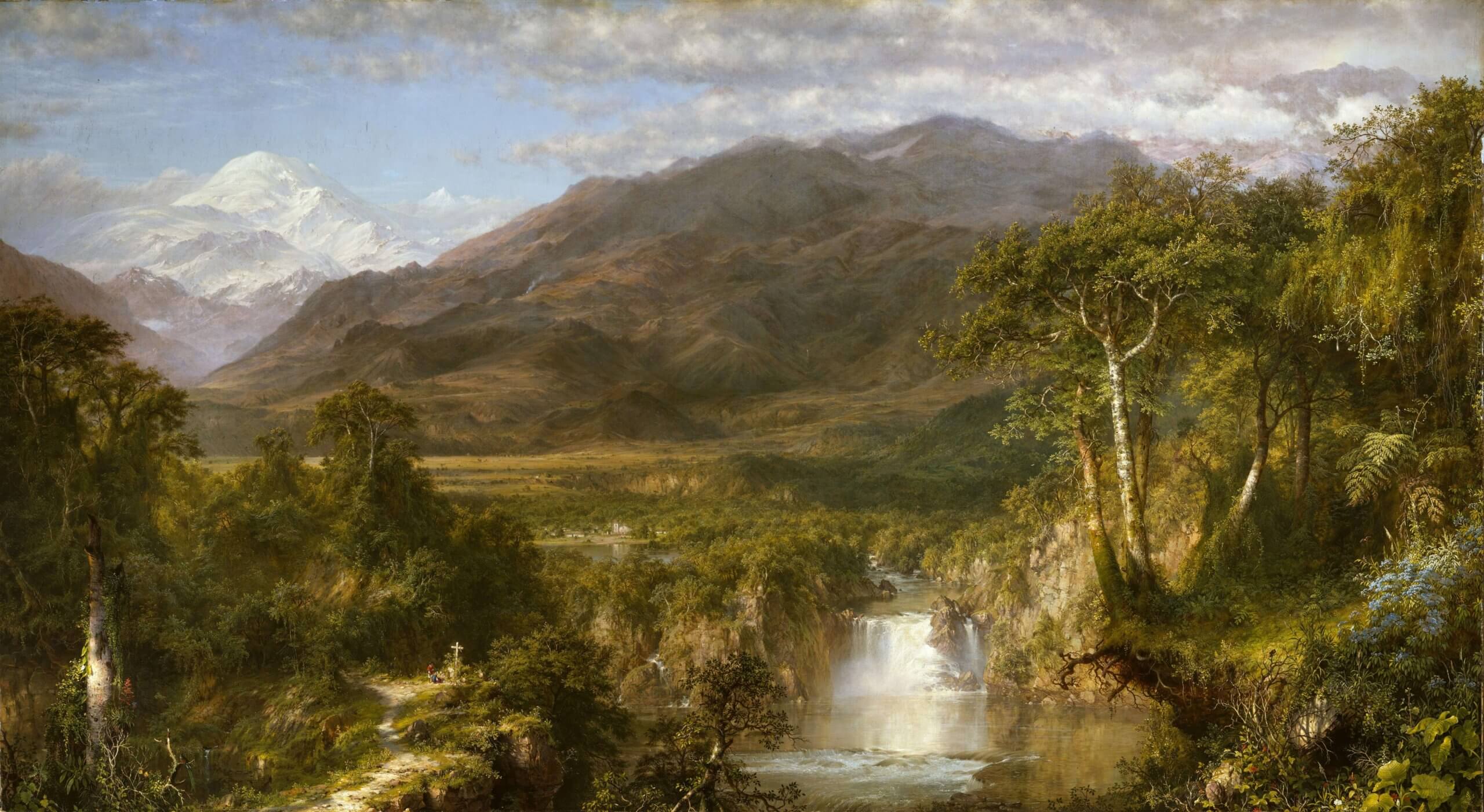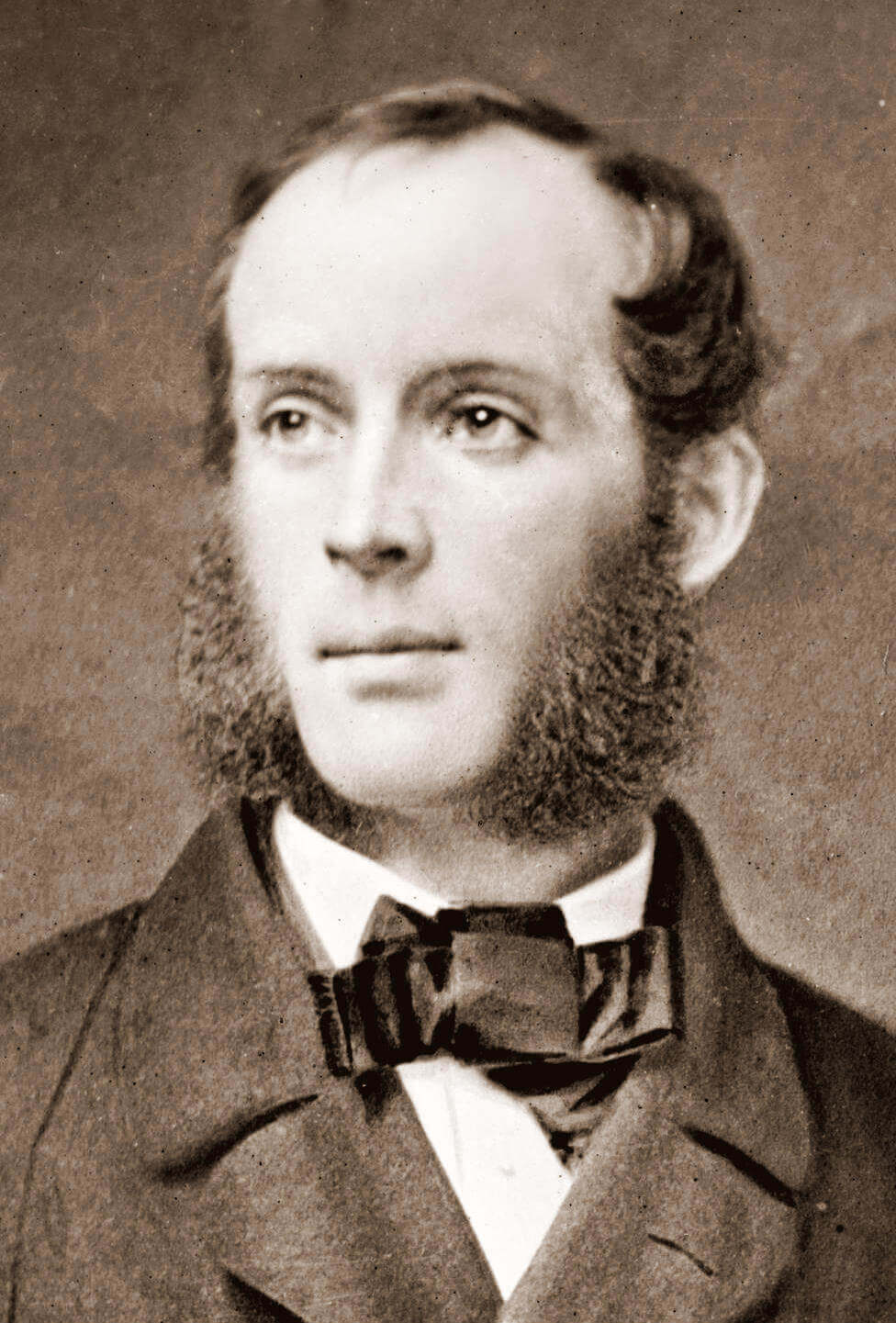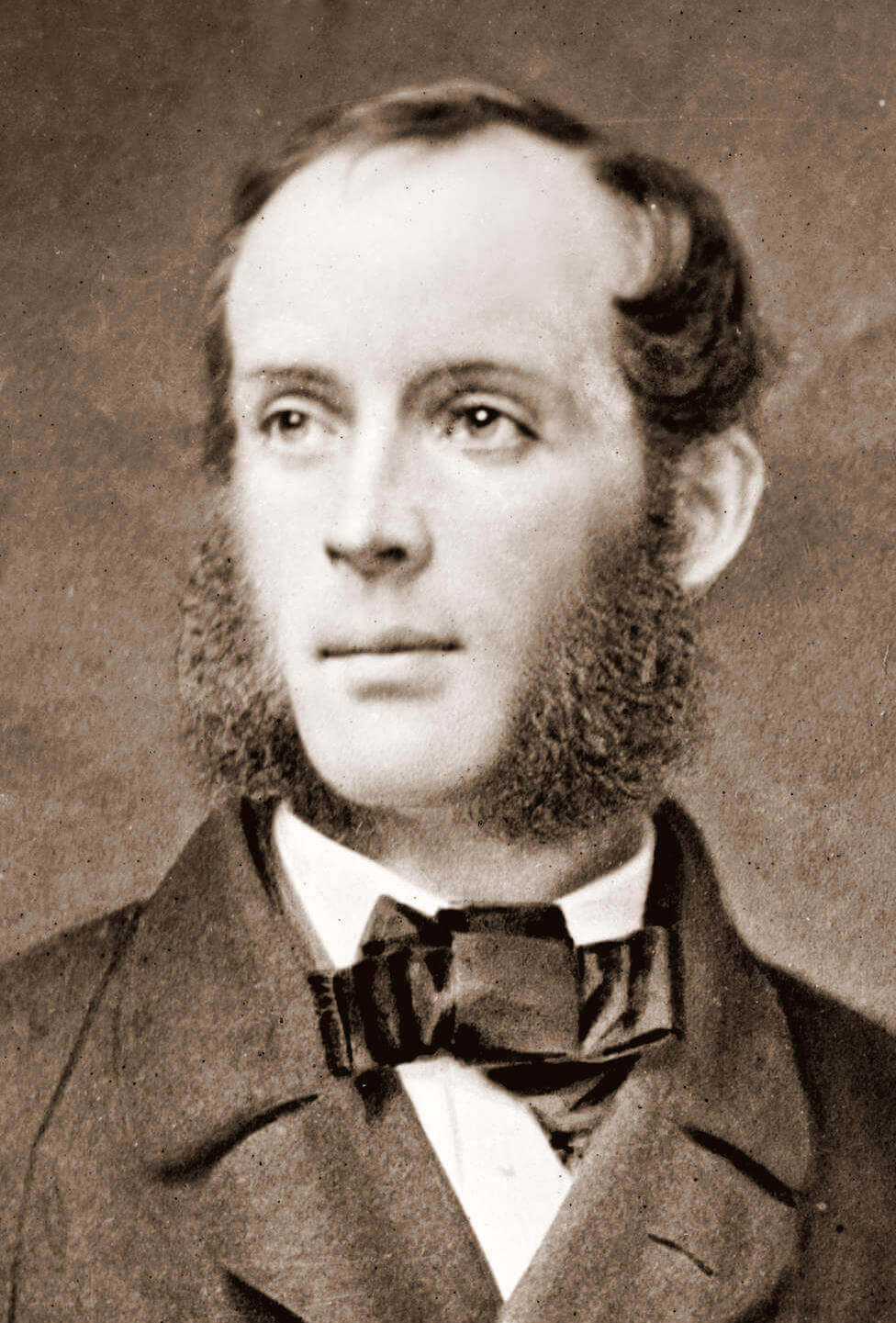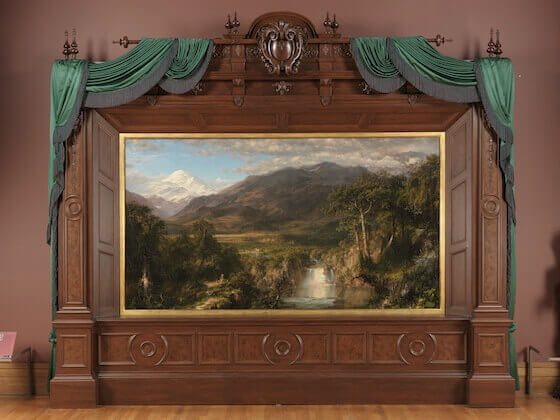

One of the most prominent painters of the Hudson River School, Frederic Edwin Church, was known for his breathtaking landscape paintings and meticulous attention to detail. “Heart of the Andes,” a masterpiece that transports viewers to South America’s majestic mountains and verdant valleys, is one of his most well-known pieces. In this in-depth blog post, we travel into the enthralling world of Frederic Edwin Church’s “Heart of the Andes,” examining its artistic significance, historical setting, and the meticulous methods used by the artist.
The Inspiration behind “Heart of the Andes”
Understanding the motivation behind the artist’s extraordinary masterpiece, “Heart of the Andes,” is crucial if one is to fully appreciate the beauty of Frederic Edwin Church’s work. Church embarked on a remarkable journey to the Andes Mountains of South America because of his fascination with the natural world and his insatiable wanderlust, where he discovered the inspiration that would shape his artistic vision.
Midway through the 19th century, Church made some trips to South America that were significant turning points for his artistic career. Church set out on an expedition to the Andes because he was drawn to the region’s dramatic landscapes and rich biodiversity. He was determined to paint this majestic mountain range’s essence. He explored uncharted territory, climbed lofty peaks, and became immersed in the Andean region’s vibrant culture and alluring natural beauty.
With their towering peaks, gushing waterfalls, and lush valleys, the Andes Mountains served as a constant source of inspiration for Church. He was profoundly affected by the size and grandeur of the surroundings, which inspired him to create works of art that would capture that sense of wonder and awe. The challenging topography, colourful flora, and dramatic interaction of light and shadow served as the foundation for his artistic exploration.
Church’s artistic perspective was greatly influenced by his experiences in the Andes. He meticulously captured the nuances of the landscape through sketches, plein-air paintings, and a vast collection of visual references. In order to capture the essence of the Andean ecosystem with unmatched accuracy and authenticity, he studied its distinctive features, from the varied flora and fauna to the geological formations.
Church’s artistic vision was further enhanced by his encounters with the native communities and local culture while travelling. He gained a profound respect for the people who lived in these mountainous areas and made an effort to depict their presence and traditions in his artwork. In addition to providing cultural context, the inclusion of indigenous characters in “Heart of the Andes” also demonstrates how revered Church is of the people and their relationship to the land.
Beyond the actual physical features of the landscape, “Heart of the Andes” was inspired. Church was enthralled by the Andes’ spiritual and emotional resonance, as well as the area’s sense of immensity and timelessness. The sublime qualities of nature, as well as the sense of awe and transcendence one feels when faced with the magnificence of the natural world, were his main subjects.
To put it simply, Church’s trip to the Andes Mountains gave him the ideas and resources he needed to make “Heart of the Andes.” The settings he saw, the people he met, and the emotions he felt all came together to influence his artistic vision. Church was successful in capturing the spirit of the Andes in his legendary masterpiece through his meticulous attention to detail, masterful technique, and profound appreciation for the sublime beauty of nature.
The artistic direction and methods used by Frederic Edwin Church in “Heart of the Andes,” as well as the cultural significance and enduring legacy of this exceptional painting, will all be covered in the following sections.

Frederic Edwin Church’s artistic philosophy
With unmatched clarity and majesty, Frederic Edwin Church was able to capture the sublime beauty of nature thanks to his singular artistic vision. His meticulous attention to detail, acute sense of observation, and profound reverence for the natural world were characteristics of his painting style. Church sought to arouse awe, wonder, and reverence for the magnificent landscapes he encountered through his artistic vision.
Church’s dedication to accurately representing nature was one of the defining aspects of his artistic vision. He valued close scrutiny and firsthand knowledge, frequently sketching and painting outdoors to capture the subtleties of light, colour, and atmosphere. Church stands out as a meticulous and detail-oriented artist because of his commitment to accurately and authentically capturing the natural world.
Church’s artistic vision is evident in “Heart of the Andes,” where he successfully conveys a sense of grandeur and scope. The image immerses viewers in the breathtaking beauty of the landscape, taking them to the lofty peaks, gushing waterfalls, and lush valleys of the Andes Mountains. The intricate rendering of foliage, the play of light and shadow, and the complexity of geological formations all showcase Church’s meticulous attention to detail.
Church’s artistic vision is further characterised by his use of colour and light. Whether it was the delicate glow of a sunrise or the ethereal radiance of a sunset, he was a master at capturing the subtleties of natural light. Church gave his landscapes a luminous quality through deft brushwork and subtle colour gradations, adding a sense of depth and atmosphere. The painting’s dramatic and evocative use of light and shadow in “Heart of the Andes” adds to the overall feeling of awe and wonder.
Additionally, Church’s artistic vision went beyond the simple representation of actual landscapes. He aimed to capture the transcendental emotional and spiritual essence of nature in his works. Church aimed to elicit an emotional response from viewers through his careful composition and subject choice, inviting them to connect with the sublime beauty of the natural world on a deeper level.
The Romantic movement, which emphasised the individual’s subjective experience of nature and celebrated the power and awe-inspiring qualities of the natural world, had a significant impact on Church’s artistic vision. In the face of nature’s majesty, his paintings frequently evoke feelings of the sublime, including awe, reverence, and insignificance.

Exposing the Andes’ Heart
The breathtaking beauty and painstaking attention to detail in Frederic Edwin Church’s painting “Heart of the Andes” enthral viewers. It is a piece of art that invites us to lose ourselves in the Andean landscape’s depths and take in the awe-inspiring grandeur of nature. Let’s peel back the layers of this masterpiece to reveal the hidden treasures that make it a genuine work of art.
“Heart of the Andes” presents a broad view of the Andean mountains at first glance, inviting viewers to travel through its majesty peaks, cascading waterfalls, and lush vegetation visually. A remote and uninhabited region of the world is depicted in the painting, where nature reigns supreme and human presence is overshadowed by the landscape’s immense size.
Every square inch of the canvas displays Church’s meticulous attention to detail. The artwork is proof of his unwavering dedication to capturing the intricate beauty of nature. Each leaf and blade of grass has been painstakingly articulated to create a sense of depth and realism in the rendering of the foliage. The scene becomes more dynamic with the addition of the play of light and shadow, which also heightens the sense of depth and atmosphere.
Further examination of the painting reveals hidden details that demonstrate the artist’s commitment to accurately portraying the spirit of the Andean landscape. On the canvas, tiny figures that are hardly visible to the naked eye add a sense of scale and perspective. These figures, who are frequently native people or explorers, give the painting a cultural context and serve as a reminder of human presence amidst the vastness of nature.
Church’s deft use of colour and light creates an ethereal glow that bathes the landscape in a soft, almost otherworldly, radiance. One cannot help but be struck by the luminosity that radiates from “Heart of the Andes.” The mountains’ blues and greens, the flowers’ vivid colours, and the sky’s golden glow all work together to create a peaceful, serene atmosphere.
“Heart of the Andes” is a painting that elicits an emotional response rather than just depicting the actual physical landscape. The Andean mountains’ majesty and exquisite beauty inspire awe and reverence. It takes us to a place where time has stopped, where nature rules the world, and where we are made aware of our smallness in the grand scheme of things.
Church’s masterpiece has had a significant influence on the art world and continues to motivate both artists and viewers. It is a timeless work of art because of its minute details, meticulous craftsmanship, and strong emotional resonance. It reminds us of the ability of art to take us to far-off places, to awaken our senses, and to connect us to the majesty and beauty of the natural world.

The Cultural Impact of “Heart of the Andes”
Aside from being a work of art, Frederic Edwin Church’s “Heart of the Andes” is a significant cultural touchstone that has had a major influence on the art world and beyond. This famous painting has inspired artists, shaped artistic movements, and opened doors to understanding and appreciating different cultures. Let’s explore “Heart of the Andes”‘s cultural influence and enduring legacy.
The movie “Heart of the Andes” has had a significant cultural impact by influencing how people view and value the American landscape. By showcasing the splendour and grandeur of the nation’s natural landscapes in the middle of the 19th century, Church’s painting contributed to raising the status of American art. The painting’s breathtaking beauty and painstaking attention to detail gave the American landscape a status comparable to that of European landscapes. “Heart of the Andes” sparked a renewed interest in the nation’s natural wonders and became a representation of American artistic achievement.
Church’s artwork also acted as a spark for exploration and adventure. The immersive beauty of “Heart of the Andes” inspired viewers to want to visit the actual locations the painting depicted. It piqued tourists’ interest and motivated them to set out on Andean expeditions in order to see the breathtaking landscapes Church’s brush had captured. In this way, “Heart of the Andes” opened doors to cultural exploration and inspired people to venture outside of their comfort zones and take in the wonders of nature.
Beyond the realm of aesthetic appreciation, “Heart of the Andes” has a significant impact. The painting had a significant impact on environmental protection as well. Awe and reverence for the natural world were sparked by Church’s meticulous attention to detail and his ability to capture the sublime beauty of nature. “Heart of the Andes” prompted viewers to think about the need for their preservation by serving as a visual reminder of the vulnerability and significance of pristine landscapes. It fueled the era’s expanding environmental awareness and gave people a sense of obligation to safeguard and conserve the natural resources of the planet.
Additionally, “Heart of the Andes” had an impact on the growth of artistic movements. Following artists were greatly influenced by Church’s meticulous rendering of detail and his capacity to capture the interaction of light and shadow. His style and method of painting gained a lot of traction, especially within the Luminist movement, which focused on the effects of atmosphere and light on landscapes. Generations of artists have been motivated to investigate the subtleties of light and the transforming power of nature by Church’s mastery of these elements, which set a new standard for landscape painting.
Frederic Edwin Church’s Legacy
One of the most renowned American landscape painters of the 19th century, Frederic Edwin Church, left behind a significant and enduring legacy that still has an impact on the art world today. His place in the annals of art history has been cemented by his distinctive artistic approach, unwavering commitment to capturing the beauty of nature, and his pioneering spirit. Let’s examine Frederic Edwin Church’s contributions to the field of American art and their enduring effects.
The Hudson River School, a group of American landscape painters who captured the natural beauty of the Hudson River Valley and beyond, was greatly influenced by Church, who left a lasting legacy. Church, a prominent participant in this movement, significantly influenced its course and helped landscape painting reach new heights. He influenced succeeding generations of artists with his meticulous attention to detail, vibrant use of colour, and ability to capture the magnificence of nature.
Church’s exploration and portrayal of exotic and distant landscapes is one of his most important contributions to American art. Church travelled to far-flung regions of the globe to photograph the breathtaking beauty of locales like South America, the Middle East, and the Arctic, all of which were inspired by his own travels and the accounts of scientific expeditions. His ability to take viewers to these far-off places through his paintings broadened the scope of American art and encouraged a spirit of discovery and curiosity.
Church’s inventive use of lighting and atmospheric effects left a lasting impression as well. His paintings were distinguished by a sense of depth and luminosity that he achieved by deftly manipulating light, shadow, and the interaction of colours. His paintings’ immersive and ethereal qualities enthralled viewers and inspired awe and wonder. Church made a lasting impression on the genre of landscape painting with his mastery of light and atmosphere, which evolved into a defining aspect of his style.
Church’s legacy goes beyond just his artistic accomplishments, too. He was a pioneer in the field of philanthropy and art patronage, using his wealth and power to help other artists and advance American culture. Olana, his breathtaking estate with a view of the Hudson River, was built on the foundation of his collection of artwork and artefacts from all over the world. Olana is a cultural hub that honours Church’s artistic legacy and stands as a testament to his vision today.
The work of succeeding generations of American landscape painters shows Frederic Edwin Church’s influence. Today’s artists are still motivated by his meticulous attention to detail, talent for capturing the sublime beauty of nature, and spirit of adventure. His legacy serves as a poignant reminder of the value of inquiry, observation, and a strong bond with nature in the production of meaningful art.
In conclusion, Frederic Edwin Church leaves behind a significant artistic legacy. The world of American art has been forever changed by his contributions to the Hudson River School, exploration of exotic landscapes, inventive use of light and atmosphere, and charitable activities. Church’s artwork is a testament to the enduring power of nature and the artist’s ability to capture its beauty on canvas; it continues to inspire and enthral viewers. His legacy continues to be an essential component of American artistic heritage, serving as a reminder of the significant influence one artist can have on the field of culture.
Summary of Heart of the Andes by Frederic Edwin Church
The 19th-century American landscape painter Frederic Edwin Church left behind an enduring legacy that still influences the art world today. His legacy in art history has been cemented by his philanthropic activities, his exploration of exotic landscapes, his innovative use of light and atmosphere, and his influence on the Hudson River School. Church influenced succeeding generations of artists with his meticulous attention to detail, vibrant use of colour, and ability to capture the magnificence of nature. His portrayal of remote landscapes took viewers to far-off places, inspiring a sense of exploration and curiosity. Church’s paintings evoked awe and wonder thanks to his mastery of light and atmospheric effects, which added depth and luminosity. Beyond his artistic accomplishments, Church’s patronage, philanthropy, and estate Olana serve as examples of his commitment to the arts. His influence can be seen in the work of modern artists, who are motivated to create art that is meaningful and has a strong connection to nature. The profound influence of Frederic Edwin Church on American art serves as a constant reminder of the strength of nature and the artist’s capacity to capture its beauty on canvas.























